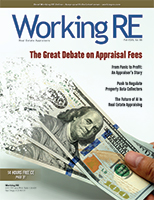 |
> TrueTracts > AMC Resource Guide > OREP E&O |
How a Chink in Your Armor Can Create an Ugly Outcome
by Richard Hagar, SRA
We’ve all been here before: The borrower doesn’t agree with your value conclusion, so like a spoiled brat stomping their feet, they complain to the appraisal management company (AMC)/client, pointing out all sorts of bogus issues. The AMC/client then performs a detailed review of your appraisal and adjustments.
This is the major inflection point between a good outcome or an ugly one. If the appraisal was completed properly and included sufficient information, this problem would go away. However, in this instance, the reviewer reads generic statements regarding how the adjustments were determined such as, “Adjustments were based on a regression analysis, matched-pair analysis, depreciated cost, and/or the appraiser’s opinion based on 20 years of experience.”
OK, but did the appraiser really perform all of these methods in this particular appraisal, or is this (and similar statements) simply a generic, boilerplate statement that could apply to every appraisal ever produced? Which data and method were used in this instance to determine the square-footage adjustment? Which method was used to determine the location adjustment? And how about that ADU? If these sorts of questions are not answered within the appraisal, then the borrower and AMC/client have a legitimate reason to question the appraiser and ask for more information and clarity.
Don’t get mad at them due to your failure to answer these questions in the appraisal. The AMC/client must waste time asking the appraiser for support for the adjustments. As the appraiser, you must stop what you’re doing and waste time answering the AMC. Everybody’s losing at this point.
Making a Bad Situation Worse
Unfortunately, in many of these instances, the appraiser really hasn’t determined the adjustments using a valid method (your opinion or 20 years in the business are not valid methods). In this example, let’s say the appraiser responds with more generic, meaningless statements such as, “The adjustments were $50 per square foot” or “The location was based on a matched-pair analysis.” The AMC/client isn’t asking you to state what is shown on the grid or the method, they are asking for specific information supporting the adjustments. Which properties were used for the matched pair? Comps #1 and #2, or some properties that are not in the report? What are their addresses? What data was used for the regression? Show it to us! Let’s see the graph.
Way too often, this back and forth goes on, and then the appraiser becomes upset and says, “Take me off your list” or “Order an appraisal from someone else.” A critical point has now turned ugly. The appraiser has created a problem that can’t fade away. According to federal law, the AMC or lender can’t simply order a new appraisal; they must find fault with the first appraisal, then turn the appraiser into the state for disciplinary action. The AMC and lender have no choice in this matter.
Here’s why: Prior to 2010, most lenders would order appraisals again and again until they got an appraisal with “the right value.” To prevent this abuse, a federal law was passed that requires a lender to review the appraisal and find a Uniform Standards of Professional Appraisal Practice (USPAP) failure likely to impact the value conclusion before they can order a second appraisal.
And then—drum roll here—the AMC and lender are required to turn the appraisal into the state for potential license revocation. This requirement applies to the client, lender, AMC, Fannie Mae, Freddie Mac, Department of Veteran Affairs (VA), and Federal Housing Administration (FHA). They have no choice. By not performing the appraisal correctly, you are allowing someone to come inside your world and look around. What will they find?
(story continues below)
(story continues)
Chink in the Armor
I just completed a review of an appraisal that had been turned into the state. The complaint was, according to the client, “due to the appraisal not listing the correct construction date, resulting in an incorrect value.” This was a bogus issue since the original construction date and date of rebuilding the house didn’t impact the description or value; it was simply an excuse to attack the appraisal’s value conclusion. This slight flaw in the appraisal—a chink or hole in the armor surrounding the appraiser—has now allowed the state to dig into the appraisal and look for any issues, even if they are not part of the complaint.
We are not perfect. If someone digs deep enough into an appraisal, they will likely find a problem. In this instance, the appraisal contained generic statements regarding the adjustments. The state obtained a copy of the appraiser’s workfile, and guess what, there was no support/proof for any adjustment.
I then looked at the photographs of the comparables. Some were taken on a sunny day, others on a cloudy day. Well, that seemed suspicious. After digging deeper, it turns out all the photographs matched the multiple listing services (MLS) photographs (a federal copyright violation). It was obvious the appraiser hadn’t inspected the comparables, a lie concerning the scope of work performed for the appraisal and indicative of an intent to mislead the lender. This is a major violation of Fannie Mae requirements, USPAP and federal law.
Hmm, wonder what else was missing from the appraisal or workfile? The cost approach stated that the land value was based on sales. However, the appraisal didn’t list any sales, and none were found in the workfile—another black mark. Bouncing over to another part of the appraisal, did the appraiser check the Highest and Best Use box and really perform and summarize the steps taken or just skip over this requirement? In this instance, there was nothing other than stating that the zoning was “residential,” and the current use is the highest and best use. Where is the summary as required by Standard Rule 2-2(a)(vii)(x)?
“The content of the appraisal report must … at a minimum summarize the information analyzed; the appraisal methods and techniques employed, and the reasoning that supports the analysis, opinion, and conclusions.”
Though I agreed with the appraiser’s value conclusion, the appraisal’s failures meant it wasn’t credible, and credibility is required by USPAP. A simple weakness, or chink in the outer armor, allowed someone else to poke all around the appraisal and methodology of the appraiser. Once a bullet gets past the outer armor, it can ricochet all around inside and cause extensive damage.
Graham Albertini, SRA, a good USPAP instructor who used to work in my office, once told me, “Appraisers must convince a reader that the information and value conclusion are correct. Convince the reader, and your problems go away.” In this particular case, the appraiser didn’t convince the borrower, the AMC, lender or state.
Solutions
Remember, this all started with a minor problem: the value didn’t make the borrower happy. This happens! Expect it. The report didn’t convince the reader that the appraiser was right.
The report contained generic statements about the adjustments, didn’t state which method was used for each adjustment or where the information came from. The appraiser said he inspected the comparables, so why was it necessary to use MLS photos instead of his own? There was no summary of the information used to reach the highest and best use conclusion. And the appraiser became upset with being questioned and told the client to “take me off your list and hire someone else.”
It was a minor problem that the appraiser could have prevented up front … in the appraisal. The report might have taken an hour longer to complete, but by trying to save an hour, the appraiser let a bullet enter and ricochet all around his world and ruin his future appraisal life.
Don’t let this happen to you. Stop being so defensive if your work is questioned. It’s the job of a good AMC to question weak appraisals. Besides, sometimes they are trying to help you. Often, they are simply pointing out your failure, so correct it and move on.
I strongly recommend taking classes on how to determine appraisal adjustments, highest and best use analysis, photograph and inspection requirements, and report writing. These classes are designed to strengthen your armor. Do it now, and get ready for the next round of business because it will be here shortly. I tell these real-life stories to help you stay safe and earn higher fees.
About the Author
Richard Hagar, SRA, is an educator, author and owner of a busy appraisal office in the state of Washington. Hagar now offers his legendary adjustments course for CE credit in over 45 states through OREPEducation.org. The 7-hour online CE course “How to Support and Prove Your Adjustments” shows appraisers proven methods for supporting adjustments. OREP members save on this approved coursework. Sign up today at OREPEducation.org. Reach Richard Hagar via email at rh@richardhagar.com.
OREP Insurance Services, LLC. Calif. License #0K99465




by drywaller
At times, they may be attempting to assist you. Frequently, they are merely highlighting your shortcomings, so address them and proceed.
-by Dave
Poor context – any idiot can talk about all the dated boiler plate included in appraisal – still encouraged by all CE. The 1004 has not been updated to reflect what we do – so obviously if a review no longer is concerned withe best data, bracketed value, and credibility – we have a double edged sword. Seriously, in this day of “hybrid” appraisals – let’s get with TODAY!
-